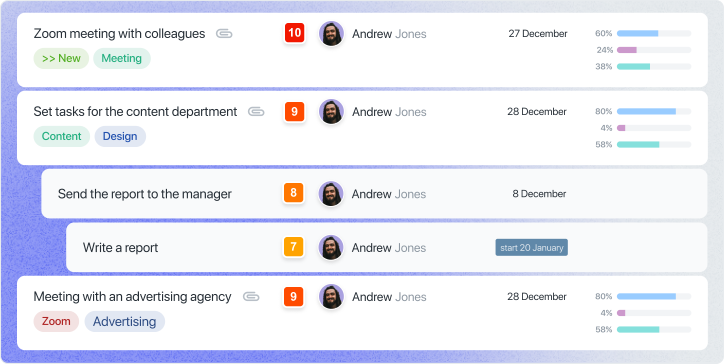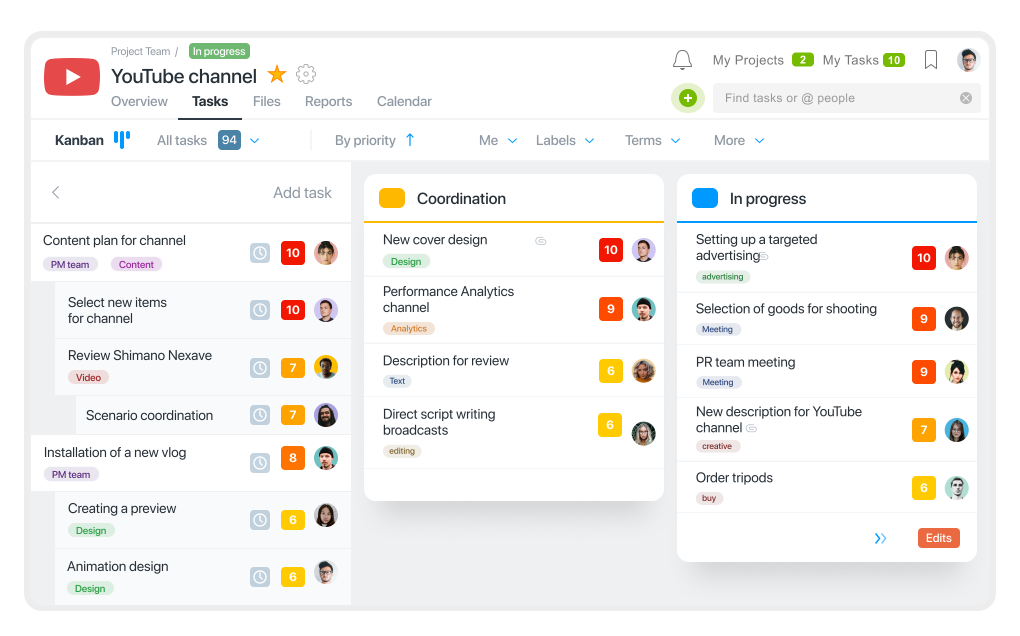When a company plans to implement a project, you can rely on intuition and the fact that all team members will make efforts to get a successful result. But, it is more likely that with this approach the result will not live up to expectations, or the deadlines and budgets will be completely different from what was expected.
To avoid this, it is necessary to follow the principles of project management. They are especially important for beginners in project management. Even experienced project managers do not neglect them, but they often adjust the basic principles for themselves. Therefore, we will talk about the fundamental principles and project management concepts, which you can use at the beginning of your work, and over time add something of your own to them.
What is Project Management?
A project is a unique set of inputs (goals, problems), processes and resources aimed at achieving expected results within a set period of time, for example, developing a new application.Based on the input data, a number of tasks of various degrees of complexity, interconnected with each other, is developed. When all tasks are completed, the project is usually complete.
In simple terms, project management is the organization of the use of company resources. The main goal of project management is to achieve the goal set at the beginning within the specified time and without exceeding the planned expenditures.

That is, the project management can be considered high-quality, if the team managed to meet the planned time frame, there was no need to urgently attract a lot of additional specialists and funds. At the same time, the resulting product fully meets the requirements, set at the beginning of work.
Project Structure
For a project to succeed, there should be a manager who develops a structure — a system that brings together the elements necessary to manage the project.
The main goal of creating a project structure is to simplify daily communication and common work on tasks for the team. In addition, the structure makes the work of the team more transparent and eliminates duplication of activities and resources.
Regardless of the type of project, the concept of project management assumes that the following parts will be included in the structure:
- Processes. One of the project management tools. Under “developed processes'' we mean that there is an understanding of responsibilities and a status of a particular task or activity. We will talk about the main processes below.
- Life cycle. It must be understood for each product to ensure proper resource planning and timely project completion.
- Project management systems. According to the concept of project management, it is necessary to track the following components of each project: people, culture, organization, methodology, information, planning and control. Management systems are designed to join all the components and manage them effectively.
The Role and responsibilities of a Project Manager
A project manager is a key person, responsible for the success of a project in general.
For successful work, the manager must know the basic principles of project management well and successfully implement them.Quite often, such specialists have Project Management Professional Certification, abbreviated as PMP. This document is issued by the Project Management Institute — PMI. It is this organization that developed, published and regularly updates the "Project Management Book of Knowledge" - PMBOK ® Guide. This guide outlines the main concepts and fundamental principles of management, which are a reference point for project management all over the world.
It is important for the manager to understand that the PMBOK sets out standards that can be applied in any project, but he will have to make independent decisions and create new principles for different projects that differ from each other.
Among the main responsibilities of a manager are:
- receiving input data from customers, as well as feedback from them as work on the project progresses;
- analytics and planning of resources, in particular — formation of teams;
- communication with the team and stakeholders;
- if necessary, delegation of work;
- documentation management;
- development and implementation of the motivation system;
- reaction to force majeure, blockers, conflicts and solving other problems that may pose a risk for the timely completion of the project.

We can say that the main role of the manager is that of a conductor. He sets the rhythm of work on the project, prompts how and who should solve the problem, quickly notices mistakes and gives effective advice and instructions on correcting shortcomings.
Project Management Processes
Below are the main processes of any project. They usually follow each other, but there are situations when you need to go back to one of the previous stages to add important information, for example, from completion back to planning.
Research, initiation and planning
Almost any project is created in response to a need. To find out about this need as much as possible, a research is conducted. The obtained information is used at the stages of initiation and planning.
Initiation is the process of defining project goals, required resources and stakeholder expectations. Initiation ends with the drawing up of the charter and project offer.

During planning, the main steps to be taken to achieve the goals, their order and executors are outlined. They also analyze potential risks and ways to overcome them.
Implementation
This process is a direct implementation of what was planned. A mandatory element of performance is the tracking of work efficiency.
Testing, measuring results and iterating
Depending on the type of project and its management methodology, testing can take place either after execution or simultaneously.
After the team has verified through testing that the product is ready, that is, it performs its functions as planned, it is possible to make conclusions. That is, make reports, record what should be used in future projects, develop documentation for future owners and users of the product.
15 Basic Project Management Principles for Beginners
The PMP principles described below are based on the seventh edition of the PMBOK. It was released in 2021 and is significantly different from previous versions.
Previously, the standards outlined in the book were process-based. But specialists working on the publication came to the conclusion that it is more correct to say that the basis of effective project management is the principles themselves. Therefore, in the seventh edition, it is more about the skills needed by the manager and executors, as well as how to ensure a high level of satisfaction of stakeholders and describe the added value of the product.
In fact, the book describes 12 principles, but you should know that in practice there are many more of them. The main thing is to understand that these principles are the basis of the road to successful project management.
Set clear goals
This principle is important for absolutely every project. The goals should be
- specific;
- measurable;
- relevant;
- achievable;
- limited in time;
- agreed with all interested parties.
Goals that meet these criteria are easier to assess for achievement.
Describe the added value
The team does not always understand what the added value of the product is. It largely depends on the project. For some, the added value can be increased due to quality management, while others are willing to pay for constant feedback. It is important to understand that it is the added value that creates the final impression of a product or service.
Define the results that the customer will receive
Explain to the client exactly what he will receive. For example, a system to control the number of working hours of an employee. At the same time, it is necessary to describe in as much detail as possible:
- what functions will be available (authorization, the ability to pause the time, a table with data by day, uploading a report, etc.);
- on which devices the system will work;
- which limitations it can have.
Of course, the results must be recorded in writing, and the customer must agree.
Make a clear structure of the project
Describe absolutely all the steps that the team will take on the way to the implementation of the project. Here it is worth going from strategy to tactics, that is, from global tasks to secondary ones. For clarity, the structure can be presented as a diagram or road map.
Describe the roles and responsibilities of team members
Each person in the project should know what he or she is responsible for, who is his or her manager, and who can be addressed in case of questions.

This approach ensures more productivity and transparency, because everyone will know each others’ responsibilities, and this will also minimize the risk of task duplication.
Make up the statute
It is not necessary to describe every step of all team members. It is enough to indicate project goals, budget, main resources, interested parties and limitations.
Increase the level of responsibility in the team
Before starting direct work on the project, explain to the team members how their tasks are related to each other, what the delay at a particular stage leads to, tell who can provide assistance and so on.
Consider a remote format of cooperation
The reality is that at any moment the whole team or a part of the team may be forced to move from the office to remote work. Therefore, it is worth writing down instructions in advance, for example, about data storage to maintain access to them from any device.

Evaluate the resources
The manager must clearly understand how much time and money can be spent on the implementation of the project. Sometimes the planned indicators do not exactly match the actual ones. Therefore, it is important to agree with the customer on the maximum possible increase in resource consumption before starting work.
Study the potential risks, be proactive
Assess in advance what may prevent you from presenting the project results on time. Research, interviews with experts in this area and previous experience will help with this.

When the list of potential threats is ready, you can proceed to the development of a plan to eliminate each of them. In this way, you will significantly reduce the impact of risks on the work on the project.
Accept and note changes
When something doesn't go according to plan and you have to make changes to work processes, take it easy. If you have analyzed the risks and taken measures to overcome them, there will not be so many surprises. But it is important to document changes and results and the consequences it will lead to in the long run. Also, recording is important for external reporting to customers, they have the right to understand what is happening in the project.
Organize effective communication
Be sure to develop a communication scheme between project members. Team members should regularly communicate with each other and with the manager. Customers should also be in this chain. Of course, they probably don't need small details, but important points need to be communicated.
A useful step would be to provide interested parties, for example, with a list of messengers in which it is better to communicate and mention the contact persons for various questions.
Monitor progress
A manager must have tools to monitor the team's progress. At any moment of time, he should understand how things are going. When the manager is aware of how the project is progressing and regularly communicates this to the team, you can expect that the productivity and motivation of the team will be high.

In this process, it is important at the very beginning to set the criteria by which progress will be monitored. For example, the performance rates, budget, the ratio of the total number of tasks to completed ones, and so on.
Encourage transparency in work
Honesty and openness are very valuable. It is important for people to understand that nothing is hidden from them, and they receive a fair reward for their work. Therefore, use tools that allow you to ensure transparency, but not excessive.
For example, you can implement a task manager in which team members see that one of the colleagues regularly performs more tasks than planned for him. Accordingly, he receives bonuses. At the same time, salaries and bonuses are confidential information to which only certain employees have access.
Organize a favorable working environment
Be interested in what is important to the team and try to give it as much as possible. For someone, birthday greetings and corporate parties are of great importance, while someone wants to work only according to a flexible methodology and may even refuse a project where the cascade model will be used.

Evaluate the result and the work done for it. Make conclusions
It is always necessary to evaluate the final result and correlate it with the efforts made and the resources spent. Sometimes it may turn out that a seemingly successful project actually had many complications, and the costs for it greatly exceeded the plan.
Therefore, it is very important not to rely on the fact that all mistakes and options for solving them will remain in the manager's memory forever. Make conclusions and record them. This will be helpful for future projects.
Use of Project Management Systems
Principles are certainly important, but to make them work, you should choose the tools that will allow you to turn theory into practice. Most often, task managers are used for this. These programs allow you to get all the necessary functions within one product and not waste time and effort switching between several services.
Advantages of project management systems
Above, we have already mentioned which components project management systems help to manage.
Project management software is an optimal tool that provides the manager with the opportunity to have a helicopter view, that is, to look at the work of the team in a comprehensive way, and if necessary, to get closer and see the details.
For example, if we talk about Worksection, a Ukrainian project management system, there is a Dashboard which helps the manager see all the key indicators of the project in real time.

Taking a look at the picture, the manager can notice that the project is progressing rather slowly, the finish date has shifted significantly, and there is almost no activity on the project. This will allow the manager to track which tasks or employees are slowing down the project, identify the reasons for this in time and solve the problems.
Also, the advantages of project management software include:
- opportunities for planning automation;
- improvement of teamwork and more effective use of working time;
- reminders that minimize the risk of forgetting tasks;
- understanding the workload of the team as a whole and individual employees;
- simplification of communications and file sharing;
- optimization of reporting and financing.
How to implement a task manager
Like any innovation, task managers need preparation for their integration into the work of the team. First of all, it is necessary to take into account the general readiness of the team to work with these programs. It will definitely be higher if the manager tells in detail about the advantages that task trackers provide.
Another important point is the comprehensibility of a specific tool. It may not be easy for everyone to start using a new program, so prepare instructions and answers to common questions in advance. By the way, some task tracker developers prepare such materials themselves, and all you have to do is tell employees where to find the answers.
If standard instructions are not enough for a person, a consultation with technical support may be required. And this is also a very important point, because not all task trackers have technical support managers working promptly. Find out about it in advance, or better yet, test how long it takes to answer the users’ questions in the service you liked.
It is also worth evaluating the cost of the task tracker in comparison with the company's profits. Using the system should pay off at least in the medium term.
Knowing the basic principles of project management will benefit your business and bring the quality of your services to a new level. But do not forget about the tools that will help you turn the theory of project management into practice.
